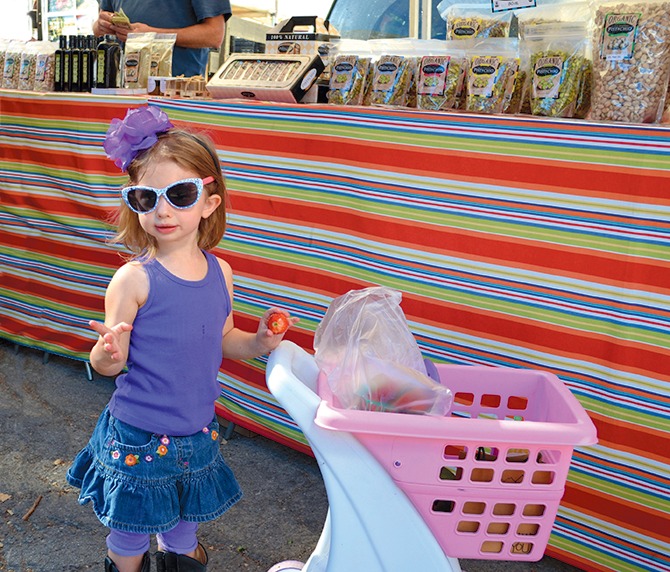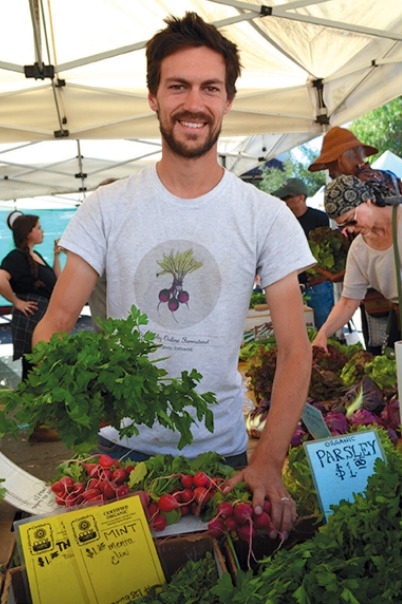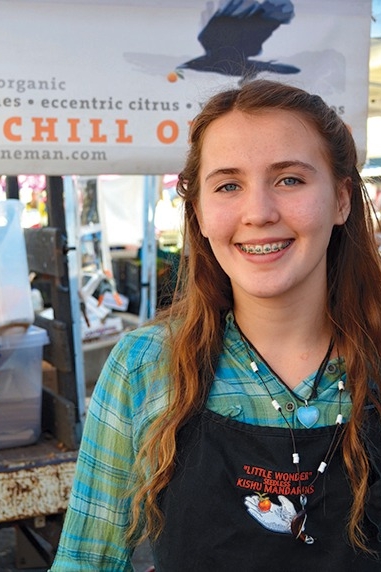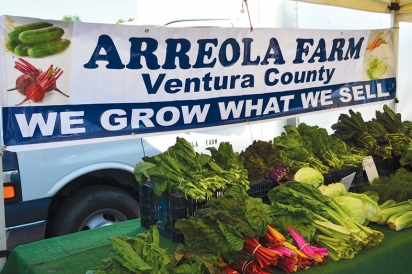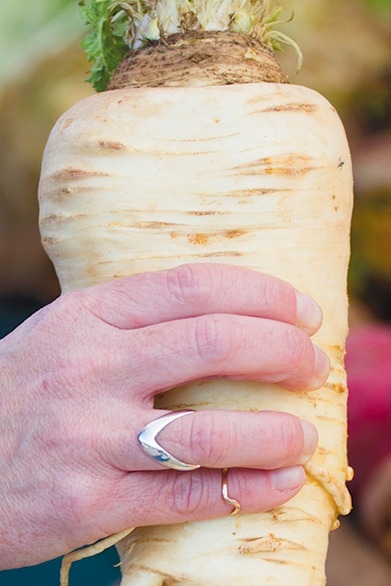Going Shopping: New Bill Aims To Ensure Honest Produce at Farmers’ Markets
Because of farmers’ markets, people now know what a real tomato tastes like, says Phil McGrath, a fourth-generation farmer on the Oxnard Plain and longtime farmers’ market vendor.
“The farmers’ markets are wonderful and have such an educational component to them. It is where the ‘Food Revolution’ started,” says McGrath, whose farm is certified organic and grows strawberries, flowers and vegetables. McGrath Family Farm sells at six markets between South Pasadena and Santa Barbara; in Ventura County at the Camarillo Saturday market and in Ojai on Sunday.
“The magic of a farmers’ market is when the farmer hands the lettuce to the consumer and the consumer pays the farmer for the product. If you are going to a farmers’ market, there should be dirt on the product; nothing is uniform; there should be big apples and small apples. It’s not going to be consistent. Every week it’s going to be different.”
“Even in paradise there’s dirt,” he says.
Apples, says McGrath, are the perfect example of the bigger picture when it comes to farmers’ markets. Because he grew up on a farm, McGrath understands our soils, seasons and variations in weather, and knows exactly what it takes to grow and harvest a crop, such as apples, which are harvested in the fall.
“So, when you eat an apple in May, that apple’s been in a cooler for six months, typically,” says McGrath.
Most farmers’ market advocates agree that the story of farmers honestly selling their own produce, fresh-picked, is a story that needs to be told—legally and ethically.
Relationship Building
Farmers’ markets often help customers by locating an information booth on premises and requiring vendors to have proper booth signage. Still, customers like to ask questions of the farmers and farmers’ market staff, says Karen Schott, operations manager for the Ventura County Certified Farmers Market Association (VCCFMA), a nonprofit cooperative.
“We have some very dedicated foodie types,” says Schott. “People are always asking questions about what we’re carrying. Farmers will give advice on cooking and new varieties. The consumer brings cooking tips and ideas to the farmers as well.”
Composer and musician Charles Barth is an avid farmers’ market patron who usually attends three local farmers’ markets each week. As a customer, he says, “I always wanted to know everything about the way the fruits, vegetables and animals were raised.”
“That was the value proposition that direct access to farmers offered: transparency. Weighed against any other option—besides growing your own—it’s by far the best value out there. To me, the value of the farmers’ market is nutritional density, being able to speak with the farmers or their representatives, to follow seasonal cycles, to learn the scale of the farms that are involved doing the business,” says Barth, co-chair of the nascent Slow Food Ventura County chapter.
Shoppers at the VCCFMA farmers’ markets run the demographic gamut, including cooking enthusiasts who watch the food-themed television channels and want a specific item, pregnant women, families with small children, and senior citizens, most seeking the health benefits of fresh produce, says Schott. At the downtown Ventura location, she says, VCCFMA has approximately 1,000 shoppers each Saturday and about 500 at the Wednesday market at Pacific View Mall.
“You have relationships with these consumers. You know what they like; you know what they’re looking for, if they have special needs. It’s putting a face on your food,” says Schott. “And, as [VCCFMA] staff, we’ve really benefitted from that because we have deep relationships with our farmers and then the same with our customers.”
Schott, who has been in the agriculture industry 25 years and grows pumpkins with her husband, Tom, says the VCCFMA’s emphasis is twofold: the success of the market for its vendors and providing customer service to its consumers.
“Bottom line is I’m just as responsible to the consumer, who is supporting California agriculture,” says Schott. “Big retailers can afford to use produce as their loss leader, and if people are going to look at the dollar value, farmers’ markets are not going to be their first choice. But you’re going to find the different taste and different varieties that [local farmers] can afford to grow on a smaller scale. Big packers are not going to have those same varieties.”
Schott explains that the initial idea behind farmers’ markets was quite simple.
“The whole premise of farmers’ markets is to support California agriculture, because we’re so diverse and we can feed the world,” says Schott. “This was an opportunity for small family farmers to come in with fruit that was not all sized and graded like the bigger corporations’ and produced on a small scale.”
Farming commercially since 1975, and now with a 12-acre Meiners Oaks farm he refers to as his “garden,” Steve Sprinkel, like many others, credits Governor Jerry Brown’s 1978 passage of the farmer-to-consumer Direct Marketing Act as the impetus for farmers’ markets to thrive.
“I was involved from the beginning as a small, entry-level farmer,” says Sprinkel. “That was in 1982, at the Santa Barbara market, with a dozen growers standing in the rain in the muddy dirt parking lot.”
“The first farmers’ market I went to I made $46, and within five or six years I was able to make $4,000 per week,” says Sprinkel.
However, as farmers’ markets have multiplied over the years, the line sometimes blurred between farmers who grow their own and vendors who resell products grown by others.
Joel Grover, an investigative reporter for NBC4 Los Angeles, gets much of the credit for discovering widespread cheating in farmers’ markets. His September 2010 exposé (available on YouTube), revealed that some market vendors sold items they hadn’t grown but stated they had, or touted items as pesticide-free when they were not. This investigation was a wake-up call for those who regulate the markets.
Assembly Bill 1871
Enter Assembly Bill 1871, which went into effect in January. The “We grow what we sell” signs you see at farmers’ market booths are a result of the bill, which also requires vendors to post their name, the area of production and how the items being sold were produced.
According to Barth, a member of the Certified Farmers’ Market Advisory Committee, the new signage will protect the integrity of the farmer as well as readily inform the customer and eliminate illegal wholesaler participation.
The bill was created for three main reasons, explains Schott: to address expanded product lines within the certified farmers’ market section, to have stronger inspection services and to offer stiffer penalties when cheating is found.
Henry Gonzales, Ventura County agriculture commissioner, explains that under AB 1871 the civil penalties the California Department of Food and Agriculture (CDFA) collects from fraudulent sellers will be used for future investigations and enforcement activities with certified farmers’ markets.
“The funding will allow our staff to perform additional inspection activities involving cases of producers selling ‘product not of their own production’ or using ‘false, deceptive or misleading marketing’ tactics,” he says via email. Activities include more inspections, like comparing product sold at certified farmers’ markets to what is actually grown at the producers’ certified production sites.
At the markets, there also must be separate areas for agricultural products and other items under AB 1871. As an example, Schott cites lip balm made from honey, which isn’t allowed in the certified market section.
With so many farmers’ markets now, there aren’t enough farmers to go around, causing some event coordinators to fill up space with arts and crafts people and produce vendors, says Schott. “And that’s where it’s gotten distorted on the public view of what a farmers’ market is.”
This distortion was also a factor in the campaign to enact AB 1871, says Schott, who just completed her term as chair of the Certified Farmers’ Market Advisory Committee for CDFA. The committee advises on regulations, enforcement and administration policies and procedures related to the marketing of agricultural products at certified farmers’ markets.
The Certified Farmers’ Market Advisory Committee was integral to the development and passage of AB 1871, which had a long journey from idea to enactment and included numerous meetings and study groups. Members of the committee are market operators, certified producers (meaning farmers) and county ag commissioners, as well as a public member, which is Barth’s role.
A database is in the works to help enforcement officials more easily detect scofflaws. This will still be a challenge, according to David Karp, because there are 800 farmers’ markets in California today, versus 300 a decade ago.
Karp, a Los Angeles–based pomologist, world traveler and writer—also known as the “fruit detective”— is an expert on produce.
“A major focus of my work over the decades has been farmers’ markets’ integrity,” says Karp. “In the last couple of years, the Los Angeles County Agricultural Commissioner’s office took up the challenge and put up money and hired talent to go after the cheaters. At least 50 different farms have been cited in the last two years.”
For Karp, what’s most important for consumers is to choose to go to farmers’ markets in which there are fewer cheaters, an aspect that greatly depends on the tenacity of the management.
“With AB 1871, for the first time we have funding for adequate enforcement and hopefully that’ll lead to adequate enforcement,” he says. “Before that, it really was sort of up to the consumer to either figure it out for themselves or hope that the manager of their market was insistent on integrity and cared about integrity because there wasn’t much in the way of enforcement.”
“The new bill will help to increase customer confidence [throughout the state] knowing the product they purchased at a certified farmers’ market is actually ‘California Grown,’” adds Gonzales.
Still, identifying “cheaters” could be difficult for the average consumer: For example, you would have to know that cauliflower or broccoli can only be grown in cooler coastal areas in order to realize the Imperial Desert–based vendor who’s selling it didn’t grow it.
As a farmer and farmers’ market vendor, McGrath believes consumers shouldn’t be afraid to ask questions of vendors, such as “‘Are you the farmer?’ ‘Do you know the farm?’ ‘Where is the farm?’ ‘Do you know about the variety?’ ‘How many workers do you employ?’”
Buzzword: Organic
Even with the increased emphasis on enforcement, it’s going to be difficult to monitor all aspects of farmers’ markets, according to Sprinkel, the farmer and co-owner of Farmer and the Cook market and restaurant in Meiners Oaks.
Sprinkel no longer participates in farmers’ markets, focusing instead on his store and restaurant. This is mostly due to the one area of farmers’ markets he believes requires significant improvement: the use of the term “organic.”
“The word ‘organic’ built all this consumer acceptance,” says Sprinkel, who uses beneficial insects on his farm and eschews synthetic pesticides. “But they don’t even know what it means … but they know it’s safe, that there are no chemicals. The lines have blurred between ‘certified’ and ‘organic.’”
This is because some farmers’ market vendors use verbiage that avoids the word “organic,” relying instead on terms such as “no spray” or “all natural,” which imply that no synthetic pesticides have been used. For many consumers this seems to be good enough, although advocates of organic certification find those broad terms deceptive.
Despite the implementation of AB 1871, this potential deception is something Sprinkel fears may not be investigated as thoroughly as it should be. Still, he remains hopeful for farmers’ markets in the future.
“The farmers’ market movement is fl awed but not a fraud. Government and consumer and farmer advocates are attempting to correct wrongs,” he explains. For the rest of us, it means the farmers’ market is still one of the best places to get fresh produce, and pick up some tomatoes that taste real.
411 ON ASSEMBLY BILL 1871
(originally AB 996)
Agricultural products: direct marketing: certified farmers’ markets
Approved by Governor Brown, Sept. 26, 2014, went into effect Jan. 1, 2015
AB 1871 in a nutshell: This bill makes it unlawful for any person or entity, or employee or agent of that person or entity, to make any statement, representation or assertion relating to the sale or availability of agricultural products that is false, deceptive or misleading. If this occurs, the Secretary of Food and Agriculture, or a county agricultural commissioner, can levy a penalty.
Before selling at a certified farmers’ market, a producer must apply for and obtain a certificate from the county agricultural commissioner’s office in the county in which the producer’s land or facility is located. Once certified, a producer farming fruit, vegetables, nuts, herbs and similar crops must submit information each year about his or her harvest. This bill also raises the vendor fee from 60 cents to $2 per day, which subsidizes investigation and enforcement expenses. Funding for the increased activities is expected to be available for Ag Commission offices in the second half of this year.



